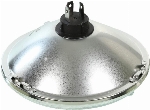On a number of 1970s TV shows filmed in California I've noticed something curious about the headlamps on some cars of the time.
Until the mid–1980s every car used sealed-beam headlamps. On those with four lights, round or rectangular, on high beam all four lamps normally came on. The low beams were only on the outer or upper lamps. This was normal throughout the US.
Except...on several of these shows, some cars in California were shown with only the two inner or lower lamps operating on high beam. I've never seen this arrangement on any older cars out my way. On high beams all four lamps would come on. But these California cars were different.
Examples of what I'm talking about include the Pontiac Firebirds used on The Rockford Files, the Corvette used on The Magician, and a few other cars here and there. Some Chrysler models appeared with this arrangement on some shows, but so far no Fords as far as I remember.
Was using only 2 headlamps on high beam of a 4–lamp system required in California in the '70s on some cars for some reason? If it was, why?
Until the mid–1980s every car used sealed-beam headlamps. On those with four lights, round or rectangular, on high beam all four lamps normally came on. The low beams were only on the outer or upper lamps. This was normal throughout the US.
Except...on several of these shows, some cars in California were shown with only the two inner or lower lamps operating on high beam. I've never seen this arrangement on any older cars out my way. On high beams all four lamps would come on. But these California cars were different.
Examples of what I'm talking about include the Pontiac Firebirds used on The Rockford Files, the Corvette used on The Magician, and a few other cars here and there. Some Chrysler models appeared with this arrangement on some shows, but so far no Fords as far as I remember.
Was using only 2 headlamps on high beam of a 4–lamp system required in California in the '70s on some cars for some reason? If it was, why?


